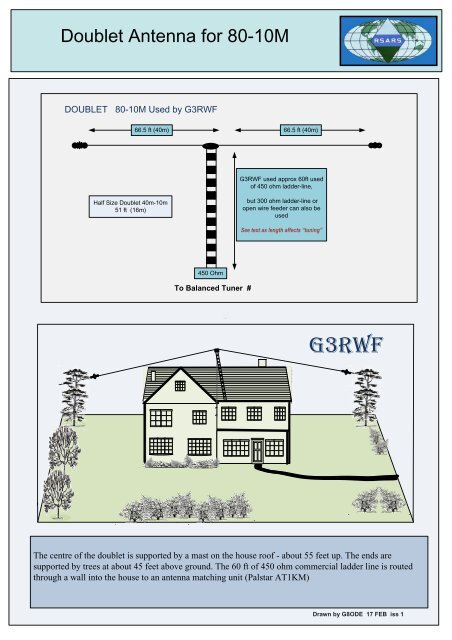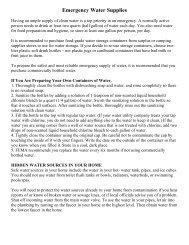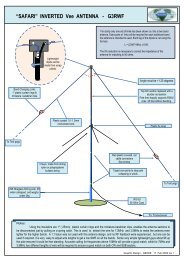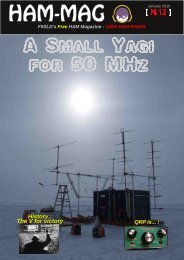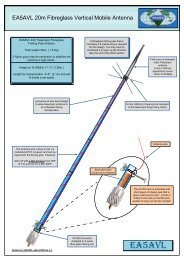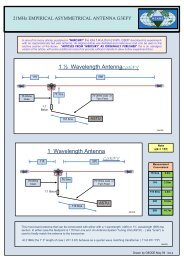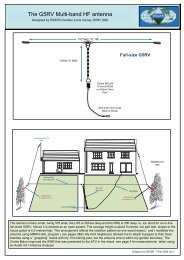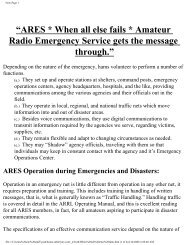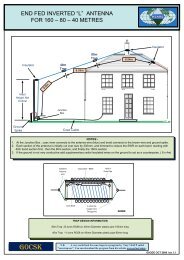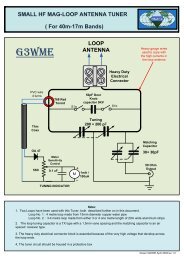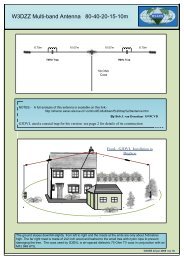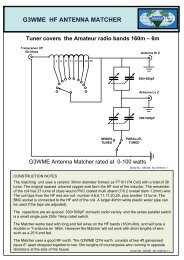Doublet Antenna for 80-10M - arkansas ares races
Doublet Antenna for 80-10M - arkansas ares races
Doublet Antenna for 80-10M - arkansas ares races
- No tags were found...
Create successful ePaper yourself
Turn your PDF publications into a flip-book with our unique Google optimized e-Paper software.
<strong>Doublet</strong> <strong>Antenna</strong> ExplainedDOUBLET DESIGN CONSIDERATIONSAn efficient doublet should be at least 1/4λ to 1/3λ at the lowest operating frequency. A 3/8λ version has anefficiency greater than 98% relative to a λ/2 dipole and can have SWR values that are reasonably easy to match.At 3.5MHz a 3/8λ dipole is approximately 100ft (30m) long, but any length from 130-90ft (40-27m) will make anexcellent radiator on all HF amateur bands <strong>80</strong>m-10m including the WARC bands. The dimensions are not toocritical, and if your real estate can’t accommodate a dipole of this length, then you can droop the last 3-4m ateach end without significantly affecting the per<strong>for</strong>mance. Alternatively a half-size 50 ft (16m) doublet will operatebetween 40m-10m.As the operational frequency is increased, the physical length of the antenna in terms of wavelength alsoincreases. Feedpoint resistance can be many thousands of ohms at multiples of 1λ, dropping to less than100ohms at 0.5λ, this is illustrated on page 4 in the plot of resistance and reactance produced from the model ofG3RWF's doublet. The wide variation in feed point impedance necessitates the use of a robustly constructedantenna matching unit (AMU), high voltages will be developed inside the AMU even with a modest 100 watts ofRF, so there is a need <strong>for</strong> wide spaced variable capacitors to prevent arcing. As the SWR on the feeder will oftenbe very high it is usually constructed with open-wire line and spreaders, however, high grade commercial 300 or450ohm ribbon feeder makes a very acceptable, if pricey, alternative.The height of HF horizontally polarised antennas above ground, in terms of wavelength, affects radiation patternsand feedpoint resistance. NVIS antennas need the ground/earth to act as a reflector, very similar to a closespaced beam, and, as such, the feedpoint resistance is usually very low, but, <strong>for</strong> the majority of amateuroperations, the height of an antenna does not play a significant part in determining radiation resistance. However,in simple terms, the height of an antenna affects the angle of radiation. An antenna 3/4λ high has an angle ofradiation of, about, 20 degrees, the angle rises to about 40 degrees at 0.5λ, if the antenna is just 0.25λ high, thena lot of the transmitted energy goes straight up. These affects are due to the influence of waves reflected from theground, but as the antenna height increases this diminishes.The doublet can also be supported using a single pole to <strong>for</strong>m an inverted “V”, but this will result in some changesin the far field radiation pattern at the higher frequencies but the effect on propagation will be negligible. Ideally anapex angle greater than 120 degrees if DX operation is required. Lower angles produce more near vertical lobes.There are two things to consider when using commercial twin feeder or home-brew ladder line.1. The feeder is likely to be unbalanced by nearby large metal objects, such as metal window frames. For shortdistances adopt the G5RV practice and connect a short segment of coaxial cable between the lengths of openwire feeder or from the end of the open wire line to the AMU. The losses in the coax will be slightly greater but itwill solve the delivery problem.2. The length of the line may have to be adjusted so that the impedance presented to the AMU unit is within itscapabilities. Be prepared to trim the line. Remember also that the resistance will repeat every half wavelength.See the MMANA-Gal model <strong>for</strong> more in<strong>for</strong>mation.Prepared by G8ODE 31 Jan 2009 iss 1.1
<strong>Doublet</strong> <strong>Antenna</strong> ModelMMANA-GAL <strong>Doublet</strong> ModelMMANA-GAL ANTENNA MODEL FOR A SIMPLE DOUBLET.Note: MMANA-GAL is freeware available on the web:- http://mmhamsoft.amateur-radio.ca/It is limited to only being able to model open-wire feeders i.e no coaxial cablesThe aim of the following modelled results is to demonstrate what happens when the length of the open wire feeder is changed .To do this the G3RWF <strong>Doublet</strong> antenna had to be modelled three times:-1. A 40 m top as per G3RWF’s <strong>Doublet</strong> & no open wire feeder - base lining feed point impedances.2. Same antenna but using a 18m, 16.5, 15m and 13.5 m open-wire 450 ohm feeders.3. The Models were initially all referenced to 50 ohms, and later repeated with a 200 ohm reference.The 200 ohm reference set of readings is included because some radio amateurs prefer to use auto-tuners and manufacturers oftenrecommend the use of a 4:1 balun, which if used with a 50 ohm transceiver translates this into a 200 ohm load,.The feeder lengths chosen provided noticeable effects on the value of the SWR readings. The conclusions are based on these as they areeasier to interpret than the complex value readings in R and jX..In each case the following MMAN settings were used;-SWR calculated relative to 50 ohms<strong>Antenna</strong> at a height of 20m and the ladder lines dropping straight down.Modelled above “Real” 5mS and dielectric of 13.G3RWF <strong>Doublet</strong> –40m antenna wire only 18m apex & slopes to 15m – base line of dipole impedancesThe MMANA-GAL model results shown that the resistance alternates between low and highvalues, and the reactance similarly changes between inductive and capacitive values as theantenna increases in terms of wavelength.Consequently the SWR relative to 50 ohms is generally very high apart from on <strong>80</strong>metres whenthe 40m dipole is exactly a half wavelength.However, all is not lost, as there is a way.Prepared by G8ODE 31 Jan 2009 iss 1.1
<strong>Doublet</strong> <strong>Antenna</strong> ModelMMANA-GAL <strong>Doublet</strong> ModelThe two graphs below were produced from MMANA-GAL results calculated using 60 differentfrequencies over the range 3MHz- 25MHz, with more points centred around the Ham bands.The top graph clearly show how the impedance varies with regards to frequency in the SWR graph,where SWR can be expressed ratio of impedances Z(ant) / Z( Tx).The lower graph shows how the doublet feed-point resistance and reactance changes in terms ofwavelength as the higher frequency ham bands are used. The antenna becomes increasingly longer interms of wavelength as the frequency goes up.120SWR100<strong>80</strong>60SWR402000.00 3.50 7.00 10.50 14.00 17.50 21.00 24.50Frequency MHz6000R+jX50004000300020001000Resistance Series1Reactance Series200.00 0.25 0.50 0.75 1.00 1.25 1.50 1.75 2.00 2.25-1000Ohms-2000-3000WavelengthPrepared by G8ODE 31 Jan 2009 iss 1.1
<strong>Doublet</strong> <strong>Antenna</strong> ModelThe effect of altering the feeder lengthThe G3RWF <strong>Doublet</strong> with its dropped arms has been modelled at a of 18m height,with the ends at 15m, only the feeder length has been changed in each model.G3RWF <strong>Doublet</strong> 18m apex slopes to 45 ft with 450R line 18m longSWR spreadRef to 50 OhmsSWR spreadRef to 200 Ohms( 1.4-52.3) to 1( 2.0-14.1) to 1G3RWF <strong>Doublet</strong> 18m apex slopes to 45 ft with 450R line 16.5m long(1.97-40.6) to1(3.66-12.2) to1G3RWF <strong>Doublet</strong> 18m apex slopes to 45 ft with 450R line 15m long(8.71-44.0) to1(5.28-12.4) to1G3RWF <strong>Doublet</strong> 18m apex slopes to 45 ft with 450R line 13.5m long(15.2-57.5) to1(7.25-15.3) to1FEEDER LENGTH CONCLUSIONSAlthough the <strong>80</strong>metre SWR increases significantly, by varying the length of the open-wire feeder and using a 4:1 Balunthe other readings can be seen to improve to values that a tuner can handle easily. The doublet’s SWR values were inthe range (1.31-69.3) to 1, by adding the transmission line and using a 4:1 balun, all four sets of results have an SWRthat is less that 16:1, and the doublet that uses at 16.5m feeder has a maximum SWR of 12.2 to 1. By carefullyadjusting the open wire feeder length it is possible to optimise the SWR readings <strong>for</strong> all the bands <strong>80</strong>m through to 10m,but not necessarily with an SWR that is lower than 2:1NOTE:-The MMANA-GAL models used are only an indication of what might be expected in a real situations, and there can be no guarantee that theprogram can replicate a real situation since there are many variables that will affect the antenna, and these cannot be modelled in a simpleprogram such as MMANA-GALG8ODEPrepared by G8ODE 31 Jan 2009 iss 1.1
<strong>Doublet</strong> <strong>Antenna</strong> <strong>for</strong> <strong>80</strong>-<strong>10M</strong>MMANA-GAL FAR-FIELD RADIATION PLOTSG3RWF <strong>Doublet</strong> modelled as 18m apex and ends at 15m with an 18m long 450 ohm open-wire feederabove “Real” Ground 5mS/m with a dielectric of 13Prepared by G8ODE 31 Jan 2009 iss 1.1
<strong>Doublet</strong> <strong>Antenna</strong> <strong>for</strong> <strong>80</strong>-<strong>10M</strong>MMANA-GAL FAR-FIELD RADIATION PLOTSG3RWF <strong>Doublet</strong> modelled as 18m apex and ends at 15m with an 18m long 450 ohm open-wire feederabove “Real” Ground 5mS/m with a dielectric of 13Prepared by G8ODE 31 Jan 2009 iss 1.1
<strong>Doublet</strong> <strong>Antenna</strong> <strong>for</strong> <strong>80</strong>-<strong>10M</strong>SUMMARISING THE DOUBLET ANTENNAThe doublet is a very versatile antenna that can be used in a variety of configurations. Ideally itshould be fed from a balanced “tuner” to keep the electrical loses to a minimum. The use of a ferritebalun is not really recommended because cross modulation can occur with high power levels.Additionally if high power levels are used with a severely mismatched balun very high voltages canbe developed such that even solder around joints could melt!It is also worth noting that some of the commercial “tuners” use ferrite baluns (mostly toroids) toaccommodate open wire feeders. So it's case of "buyer beware"!Some articles specify the feeder length that has to be used with a particular size of doublet. From theprevious pages the reason <strong>for</strong> this should now be clear, and is done so that the “tuner” has a moreacceptable and easy to match set of impedances <strong>for</strong> each band. This situation was modelled usingthe MMANA-GAL program, helps to explained why this happens. In fact if the resulting end of thefeeder impedances are too large the “tuner” may not be able to null them out.As suggested in the MMANA-GAL model conclusions, the simple cure is to either to change thedoublet length or to change the length of the feeder. By adjusting any of these the lengths theimpedance that the “tuner” sees, will change. In most cases its probably easier to juggle with thefeeder length than to adjust the size of the doublet. Occasionally in order to optimise the SWRreadings across the whole of the bands adjustments to both the doublet length and feeder will berequired be<strong>for</strong>e the “tuner “ can easily provide a match on every band.The simulation clearly indicates that the transmission line ( feeder) not only delivers the RF power tothe doublet, but is also helps to reduce the doublet’s various impedances to more manageablevalues than the “tuner” can handle. The uses of a balun helps to further reduce the range of SWRvalues that are presented to the tuner. The reduction in impedance will vary from band to bandbecause the relative length of the feeder in terms of wavelength changes with each band and hencethe impedance presented to the tuner.Finally one of the most popular aerials around today is Louis Varney’s (SK) G5RV and is a specialcase doublet. The transmission line is designed to act as a quarter wave trans<strong>for</strong>mer on 20m and a “variable trans<strong>for</strong>mer” on the other bands. It also uses a coax to connect to an unbalanced tunerwhich is very often connected via a 1:1 balun or choke balun.A special thanks to G3YEU <strong>for</strong> his assistance in preparing this PDFPrepared by G8ODE 31 Jan 2009 iss 1.1


